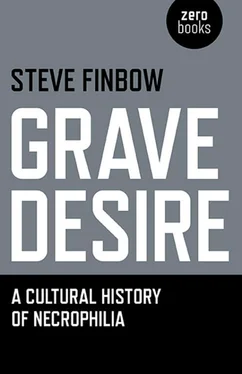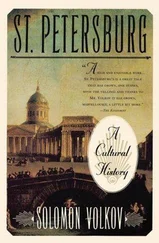Not so the necrophile. Be it a fantasist or a murderer, the necrophile obsesses on his or her desires and sensory stimulation, goes beyond any “will” to suppress their inclinations. But that is no different than the desiring drive of a paedophile, a homosexual, a heterosexual. The homicidal and the regular necrophile, however, must transgress morality and ethical standards by committing murder and rape.
Is the necrophile, in whichever guise, an anti-Kantian, a Nietzschean, rebelling against the injustices of society’s ethical straitjacket? Written and published in 1887, a year before Jack the Ripper’s murder spree in London, Nietzsche states in The Genealogy of Morals, ‘Hostility, cruelty, pleasure in persecution, in assault, in change, in destruction—all that turning against the man who possesses such instincts: such is the origin of “bad conscience”. The man who is forced into an oppressively narrow and regular morality, who for want of external enemies and resistance impatiently tears, persecutes, gnaws, disturbs, mistreats himself, this animal which is to be “tamed”, which rubs himself raw on the bars of his cage, this deprived man consumed with homesickness for the desert, who had no choice to transform himself into an adventure, a place of torture, an uncertain and dangerous wilderness—this fool, this yearning and desperate prisoner became the inventor of “bad conscience”.’ [264] Friedrich Nietzsche, On the Genealogy of Morals, trans. Douglas Smith (Oxford, 1996), p. 65.
It is certain that Kürten, Gein, Dahmer, West and Miyazaki all considered themselves oppressed by a narrow morality, felt persecuted by society and rubbed themselves raw on the bars of sexual constraint until they burst free with acts of murder, rape and necrophilia. But what about von Cosel, Greenlee, the Grunke brothers? What about the Swedish woman with her skeleton sex toy, her ossified dildos? Even with necrophilia, morality must be relative. Nietzsche again, ‘So we modern men, because of the complicated mechanism of our “starry sky”—are defined by differing moral codes, our actions shine with differing colours in alternation, they are rarely clear—and there are a good many cases when we perform many-coloured actions.’ [265] Friedrich Nietzsche, Beyond Good and Evil, trans. Marion Faber, (Oxford, 1998), p. 110.
If necrophilia is wrong how wrong is it? Where do a living person’s rights end and a corpse’s begin?
Arguing about moral calculi, William T. Vollmann hypothesizes a scenario in which a mother and child are tortured, ‘Plato describes the greatest folly of all as being “that of a man who hates, not loves, what his judgment pronounces to be noble or good, while he loves and enjoys what he judges vile and wicked.”’ [266] Rising Up and Rising Down, p. 84.
Yet a necrophile pronounces what society may judge vile and wicked as noble and good. The moral calculus is inverted. Quoting Aquinas, Vollmann continues, ‘As a man: “Consists in the perfection of his reason in the cognition of truth and in the regulation of his inferior appetites according to the rule of reason, for a man is a man by his rationality.”’ [267] Rising Up and Rising Down, p. 86.
However much necrophilia is an ‘inferior appetite’, perpetrators from Bertrand to the Swedish woman used rules of reason and rationality to satisfy their obsession. The moral calculus can be applied to Gein as well as Greenlee and the Grunkes, ‘maybe there are some good people, too—isn’t everyone good by his own lights?’ [268] Rising Up and Rising Down, p. 99.
after all, ‘most of us expediently rig our own moral calculuses in such a way that our actions become automatically justified in accordance with our own urgencies.’ [269] Rising Up and Rising Down, p. 141.
Both West and Miyazaki believed their victims were ‘asking for it’ and that their subsequent deaths and violation were mere consequences. West perceived his victims as sex objects, flesh dolls, whereas Miyazaki believed the young girls he murdered, raped and cannibalized were hentai cartoons reified for him to enact his fantasies.
If, as Aristotle argues in The Nicomachean Ethics, [270] See Aristotle, The Nicomachean Ethics, (Oxford, 2009).
virtue is an ongoing education begun in childhood, then necrophiles (of whatever intensity) counter that education with an inverse obsessive fantasy weakening the regulative concept of morality. Necrophiliac tendencies usually begin at an early age, as in the cases of Bertrand, Kürten, Gein, Dahmer and West. If virtues are habits of the soul developed through practice, then necrophilia (and any other paraphilia) is a habit of the body also developed through practice. Aristotle, writing 100 years before Herodotus’s description of Egyptian necrophilia, states that happiness ( eudai-monia ) satisfies human desire and contains no evil, that it is achieved through reason and that pleasure is a result of virtuousness and that shame results in pain. Freud sees the pleasure principle as instinctual and not a matter of rationality or reason, pleasure and pain as the main indicators of our perverse behaviour. Freud’s reality principle is closer to Aristotle’s idea of moral virtue and anchors the self with personal moral principles in tandem with societal ethics, whereas the pleasure principle is obsessed with instant gratification and the avoidance of psychological pain. Necrophiles go beyond the reality principle, beyond Aristotle’s moral virtues, to go beyond the pleasure principle, and leap into the death drive, ‘the hypothesis of a death instinct, the task of which is to lead organic life back into the inanimate state,’ [271] Sigmund Freud, ‘The Ego and the Id,’ On Metapsychology (Middlesex, 1987), p. 380.
they desire to be at one with the thing they desire. ‘Freud knew it well: the death drive is opposed to the pleasure principle as well as to the reality principle. The true evil, which is the death drive, involves self-sabotage. It makes us act against our own interests.’ [272] Violence, p. 87.
The necrophile, from Greenlee to Gein, is driven by a desire for death and for sex; for some, like Greenlee it is out of a morbid fetishization of dead bodies, for others, like von Cosel, it is an obsessive love. The moral calculus must be adjusted in these cases to understand that, however repugnant acts of necrophilia are to the majority of society, however upsetting these bodily transgressions of loved ones must be for relatives and friends, Greenlee and von Cosel did not set out to cause pain or humiliation. It is arguable that they created their own form of happiness with their personal eudaimonia—good spirits. In the case of the Swedish women, the skeleton was anonymous, the bones came from all around the world. If we were to draw up a moral calculus of necrophilia would begin with the pseudonecrophiles who fantasize about necrophilia such as the Grunkes move through the Swedish woman’s Paul Delvaux-like obsession with skeletons and sex, and then on to the likes of Greenlee and von Cosel, and a sharp upward curve to Gein and Bertrand and finally to the infinite series of Christie, Bundy and Dahmer.
It is only recently, in the past two decades, that necrophilia has appeared in the legislation as a specific crime. Owing to the cases of Coutts, Cooper and the Grunkes, laws have been passed making necrophilia a crime in its own right and as a consequence extending the rights of the living to the dead, because the dead cannot say yes, cannot consent to or even acquiesce to sexual activity then any such acts are deemed as rape or molestation and carry more sever sentences than previously when necrophilia was either unrecognized as a crime or grouped with other misdemeanours and punished thus—theft, vandalism, grave-robbery. In the Philippines, after the trial of Randy Uro Galvez, the Tomb Raider, legislation was introduced stating that ‘whenever the crime of necrophilia is committed by two or more persons, or by any person in whose care or custody such female corpse is found, the penalty shall be death.’ (see Aggrawal for a more detailed study of the legal aspects of necrophilia). What is certain is that there seems to be no increase in necrophiliac acts but a growing willingness to report the cases and a morbid and macabre interest in this extreme taboo.
Читать дальше












